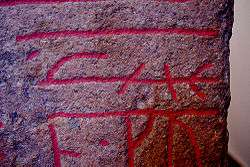Sønder Kirkeby Runestone
The Sønder Kirkeby Runestone, listed as runic inscription DR 220 in the Rundata catalog, is a Viking Age memorial runestone that was discovered in Sønder Kirkeby, which is located about 5 kilometers east of Nykøbing Falster, Denmark.
Description
The Sønder Kirkeby Runestone has been known to Danish antiquarians since 1802 when it was discovered in the northwest wall of the church in Sønder Kirkeby.[1] Before the historical significance of runestones was understood, they were often reused as building materials in the construction of roads, bridges, and buildings. The stone was removed by the Danish Antiquarian Commission in 1811,[1] and it is currently on display at the National Museum of Denmark in Copenhagen. The runestone, which is 0.79 meters in height, is known locally as the Sønder Kirkeby-stenen.
The inscription consists of four lines of runic text in the younger futhark that are below the image of a ship. Portions of the inscription and the ship image are damaged, which probably occurred when the stone was sized for use in the church wall. The Sønder Kirkeby Runestone is classified as being carved in runestone style RAK. This is considered to be the classification for the oldest style and is used for inscriptions where the ends of the runic text bands are straight and do not have any attached dragon or serpent heads. The inscription is dated as being carved after the Jelling stones.
The runic text states that the stone was raised by Sassur as a memorial for his brother Ásgautr, with the damaged text reconstructed as stating that the brother died in Gotland, Sweden. Other runestones which mention Gotland include Sö 174 in Aspö, the now-lost U 414 in Norrsunda, U 527 in Frötuna, U 614 in Torsätra, DR 259 in Fuglie, possibly Sö 47 in Vålsta, where the text has been damaged, and with U 375 in Vidbo referring to a location on Gotland.[2]

The inscription also has an invocation to the Norse pagan god Thor to "hallow these runes" that is hidden using three bind runes located in the waves below the image of the ship.[3][4] A bind rune is a ligature that combines one or more runes into a single rune. In this case, one bind rune combines the runes þ=u=r for the name Thor, another the runes u=i=k=i for the word wigi or "hallow," and a third the runes (r)=u=n=a=ʀ for the word runaʀ or "runes." Because the runes are vertically separated along a common stave, runologists further classify these bind runes as being same-stave runes.[5] Another example of an inscription using same-stave runes is the Swedish runestone Sö 158 at Ärsta.[5]
The reason for hiding the invocation to Thor is unknown, but it is clearly intended to be hidden.[4] As the Sønder Kirkeby Runestone is dated as being carved after the Jelling stones, one of which commemorates the Christianization of Denmark under King Harald "Bluetooth" Gormsson in the 960s, it is possible that it was done to conceal continuing belief in the older religion as Christianity was becoming more dominant.[6] There are two other runestones that have similar invocations to Thor located in Denmark, DR 110 from Virring and DR 209 from Glavendrup, and three other stones in Sweden, Ög 136 in Rök, Sö 140 in Korpbron, and Vg 150 from Velanda.[7] The wording of the invocation on the Sønder Kirkeby Runestone is most similar to that used on the Glavendrup stone.[4] It has been noted that Thor is the only Norse god who is invoked on any Viking Age runestones.[8]
Inscription
Transliteration of the runes into Latin characters
- (-)-sur : sati : stin : ¶ þinsi : haft : osk(u)... ¶ bruþur : sin : ian : ... ¶ uarþ : tuþr : o : ku... ¶ þ=u=r : u=i=k=(i) : (r)=u=n=a=ʀ (:) ...[9]
Transcription into Old Norse
- [Sa]sur satti sten þænsi æft Asgo[t] broþur sin, æn [hann] warþ døþr a Go[tlandi]. Þor wigi runaʀ [þæssaʀ].[9]
Translation into English
- Sassur placed this stone in memory of Ásgautr his brother, and [he] died on Gotland. May Þórr hallow [these] runes.[9]
References
- Stephens, George (1868). The Runic Hall in the Danish Old-Northern Museum. Michelsen and Tillege. pp. 10–11.
- Zilmer, Kristel (2005). "'He Drowned in Holmr's Sea - His Cargo-Ship Drifted to the Sea-Bottom - Only Three Came Out Alive': Records and Representation of Baltic Traffic in the Viking Age and Early Middle Ages in Early Nordic Sources" (PDF). Dissertaiones Philologiae Scandinavicae. Tartu University Press: 129, 134–35, 217. ISBN 9789949110896. Archived from the original (PDF) on 20 July 2011. Retrieved 11 July 2011.
- McKinnell, John (2005). Meeting the Other in Norse Myth and Legend. D. S. Brewer. p. 117. ISBN 1-84384-042-1.
- McKinnell, John; Simak, Rudolf; Dwel, Klaus (2004). Runes, Magic and Religion: A Sourcebook (PDF). Vienna: Fassbaender. pp. 119–120. ISBN 3-900538-81-6.
- MacLeod, Mindy (2002). Bind-Runes: An Investigation of Ligatures in Runic Epigraphy. Uppsala Universitet. pp. 16–18, 158–59, 162–163. ISBN 91-506-1534-3.
- Gelting, Michael H. (2007). "The Kingdom of Denmark". In Berend, Nóra (ed.). Christianization and the Rise of Christian Monarchy: Scandinavia, Central Europe and Rus' c. 900-1200. Cambridge University Press. pp. 84–87. ISBN 0-521-87616-8.
- Sawyer, Birgit (2000). The Viking-Age Rune-Stones: Custom and Commemoration in Early Medieval Scandinavia. Oxford University Press. p. 128. ISBN 0-19-820643-7.
- Page, Raymond Ian (2001) [1990]. Norse Myths. University of Texas. p. 41. ISBN 0-292-75546-5.
- Project Samnordisk Runtextdatabas Svensk - Rundata entry for DR 220.